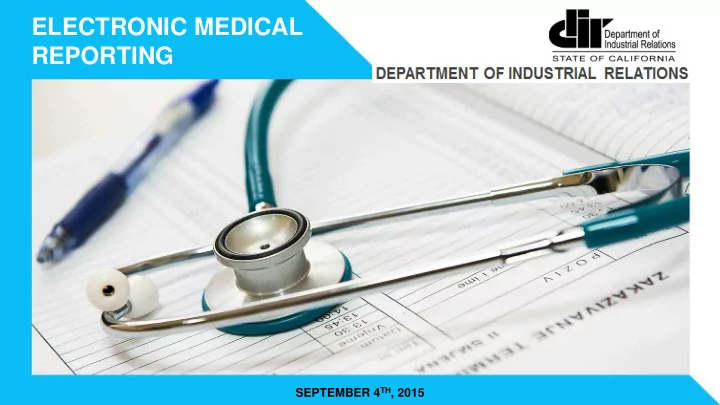

ELECTRONIC MEDICAL REPORTING SEPTEMBER 4 TH , 2015
AGENDA Electronic Medical Reporting September 4 th , 2015 10 a.m. – 12 p.m. Panelist Agenda Robert Rankin 10:00 - 10:05 Introduction IT Project Manager 10:05 - 10:10 Goals 10:10 – 10:20 Overview Destie Overpeck 10:20 – 12:00 Discussion Administrative Director George Parisotto Acting Chief Counsel Richard Newman Chief Judge Rupali Das, MD Executive Medical Director Eduardo Enz • CHSWC
Electronic Medical Records Goals
Electronic Medical Records Goals Improve processing time in providing medical care • Improve oversight, accuracy and accountability • Expedite payments to providers • Reduce administrative costs •
Role Report Process Summary Generated by physician at every first patient encou nter where an occupational illness/injury is suspect DFR – Doctors Physician ed First Report The RFA is generated at every visit if treatment is r ecommended and submitted to claims administrato Claims UR RFA - Request for r. Only 1 RFA per visit, but multiple RFAs possible Authorization per worker. Treat- UR is conducted by claims admin to assess ment PR2 necessity of treatments – may be conducted by Denied URO organization IMR Applica IMR Worker Worker submits IMR application along with UR tion form determination to Maximus. Maximus requests medical records from claims admin Treat- ment Approved Primary Treating physicians initial report and final PR3/4 reports of permanent disability
Area Challenges Benefit Medical Reporting Forms/Reports Coordination between providers a Timeliness of claims processing • • DFR nd claims administrations Improves accuracy • RFA Standard form/report format Improved performance, reliability and scalability • • PR2 Access to current data • PR3 Delays in processing • PR4 Process Lack of access to current data for Saves money and resources • • UR/IMR UR Medical decisions for injured workers are faster • Delay in decisions due to paper Better accountability • • processes - IMR Better record/data tracking • No standardized report • format/validations Process Current reports are not electronic Enhances quality of dispute resolution • • QME reports Improves ability to review quality reports • Better access to data • Process Mandated process Expedites and ensures more timely medical bill payments • • eBilling Inconsistent adoption Higher productivity, lower operating costs • • Some data is electronic currently • and some is not (PDF and attachm ents)
Medical Reporting Questions and Issues DFR Discussion DFR current state? What is being done today? What is current capability (EDI, XML, other…)? Where do we start? Greatest challenges Ideal conversion time – transition to electronic reporting How capability is realized (in house, vendors, package software….) What could the DFR in the future look like?
Further Ideas/Questions? Please email us at: EMR@dir.ca.gov
Recommend
More recommend